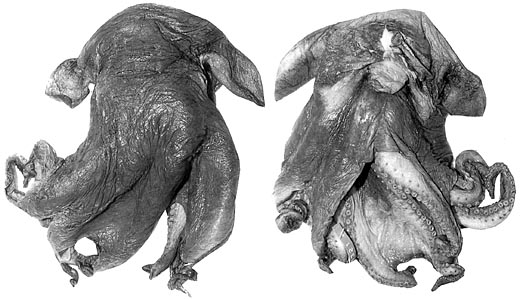Cirroctopus hochbergi
Steve O'Shea, Richard E. Young, and Michael VecchioneIntroduction
Cirroctopus hochbergi was described from 48 specimens but is known only from a restricted area off the northeast coast of New Zealand.
Characteristics
- Shell
- Shell V-shaped with short saddle.
- Shell surface rugose.
- Basal shelf absent.
 Click on an image to view larger version & data in a new window
Click on an image to view larger version & data in a new window
 Click on an image to view larger version & data in a new window
Click on an image to view larger version & data in a new window
Figure. Shell of C. hochbergi. Left - Posterior view of saddle; dorsal view of shell; lateral view of wing. Drawings from O'Shea (1999). Middle - Dorsal view of shell (left with tip of one wing missing), preserved. Right - Oblique view showing dorsal surface of saddle and lateral surface of wing, preserved. Female, ca. ... mm ML. Photographs by R. Young from a specimen sent by S. O'Shea.
- Oral-surface pigmentation
- Oral surfaces of web sectors A, B and C (to sucker 16-18) and D and E (to sucker 12-13) deep mauve to purple; outer oral surfaces of web and oral surfaces of arms and suckers white to pale mauve.
Comments
The above description is taken from O'Shea (1999). More descriptive features of C. hochbergi can be found here
The highly rugose nature of the shell is in marked contrast to that of C. glacialis. However, the shells of C. hochbergi were from specimens frozen prior to fixation. The effect of freezing on the surface texture of the shell is unknown. The mantle septum also differs greatly between these species. The thick, gelatinous septum of C. glacialis is represented by a thin membrane in C. hochbergi although this, also, could be an artifact of freezing prior to fixation. A third feature that may separate these species is the presence of a peculiar pigmentation pattern on the oral surface of the web and arms in C. glacialis. C. hochbergi, however, has a pattern to the oral surfaces (see above).
C. hochbergi differs from C. mawsoni in having dorsal and ventral pigmentation similar (in C. mawsoni the ventral pigmentation is much lighter) (O'Shea, 1999).
Distribution
Type locality:39 58.9'S, 178 14.27'E, 800-1070 m depth off northern New Zealand. This species is known only from the vicinity of the type locality.References
O'Shea, Steve. 1999. The Marine Fauna of New Zealand: Octopoda (Mollusca: Cephalopoda). NIWA Biodiversity Memoir 112: 280pp.
Vecchione, M., U. Piatkowski and A. L. Allcock. 1998. Biology of the cirrate octopod Grimpoteuthis glacialis (Cephalopoda; Opisthoteuthidae) in the South Shetland Islands, Antarctica. S. Afr. J. Mar. Sci. 20: 421-428.'
About This Page
Steve O'Shea

Oceanic Sciences Research Institute, Auckland University of Technology, Auckland, New Zealand

University of Hawaii, Honolulu, HI, USA

National Museum of Natural History, Washington, D. C. , USA
Page copyright © 2016 , , and Steven O'Shea, ,
 Page: Tree of Life
Cirroctopus hochbergi.
Authored by
Steve O'Shea, Richard E. Young, and Michael Vecchione.
The TEXT of this page is licensed under the
Creative Commons Attribution-NonCommercial License - Version 3.0. Note that images and other media
featured on this page are each governed by their own license, and they may or may not be available
for reuse. Click on an image or a media link to access the media data window, which provides the
relevant licensing information. For the general terms and conditions of ToL material reuse and
redistribution, please see the Tree of Life Copyright
Policies.
Page: Tree of Life
Cirroctopus hochbergi.
Authored by
Steve O'Shea, Richard E. Young, and Michael Vecchione.
The TEXT of this page is licensed under the
Creative Commons Attribution-NonCommercial License - Version 3.0. Note that images and other media
featured on this page are each governed by their own license, and they may or may not be available
for reuse. Click on an image or a media link to access the media data window, which provides the
relevant licensing information. For the general terms and conditions of ToL material reuse and
redistribution, please see the Tree of Life Copyright
Policies.
- First online 13 May 2003
Citing this page:
O'Shea, Steve, Richard E. Young, and Michael Vecchione. 2003. Cirroctopus hochbergi. Version 13 May 2003 (under construction). http://tolweb.org/Cirroctopus_hochbergi/20110/2003.05.13 in The Tree of Life Web Project, http://tolweb.org/








 Go to quick links
Go to quick search
Go to navigation for this section of the ToL site
Go to detailed links for the ToL site
Go to quick links
Go to quick search
Go to navigation for this section of the ToL site
Go to detailed links for the ToL site